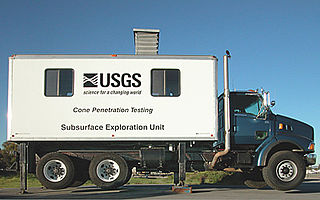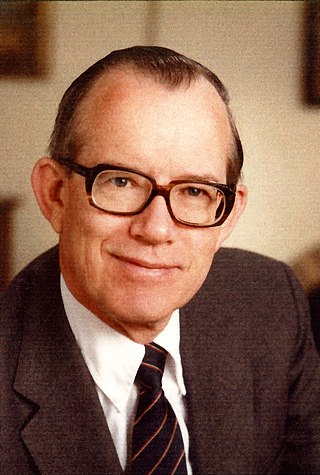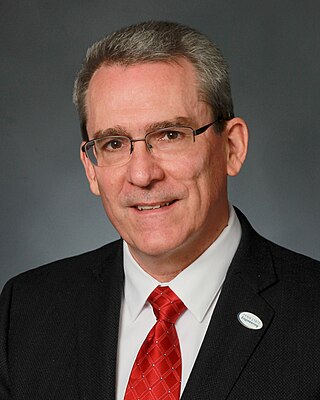Related Research Articles

The cone penetration or cone penetrometer test (CPT) is a method used to determine the geotechnical engineering properties of soils and delineating soil stratigraphy. It was initially developed in the 1950s at the Dutch Laboratory for Soil Mechanics in Delft to investigate soft soils. Based on this history it has also been called the "Dutch cone test". Today, the CPT is one of the most used and accepted soil methods for soil investigation worldwide.

The American Society of Civil Engineers (ASCE) is a tax-exempt professional body founded in 1852 to represent members of the civil engineering profession worldwide. Headquartered in Reston, Virginia, it is the oldest national engineering society in the United States. Its constitution was based on the older Boston Society of Civil Engineers from 1848.
Engineering ethics is the field of system of moral principles that apply to the practice of engineering. The field examines and sets the obligations by engineers to society, to their clients, and to the profession. As a scholarly discipline, it is closely related to subjects such as the philosophy of science, the philosophy of engineering, and the ethics of technology.
T. Leslie Youd is an American geotechnical engineer and earthquake engineer, specializing in soil liquefaction and ground failure. He currently lives in Orem, Utah.
Ralph Brazelton Peck was a civil engineer specializing in soil mechanics. He was awarded the National Medal of Science in 1976 "for his development of the science and art of subsurface engineering, combining the contributions of the sciences of geology and soil mechanics with the practical art of foundation design"?

Jack Raymond Janney, born in Alamosa, Colorado, was a U.S. structural engineer and an innovator in the understanding of structural behavior and a recognized leader in the investigation of structural collapses. Janney's love of mathematics and science spurred his decision to become an engineer, and in 1942, he enrolled in the College of Engineering at the University of Colorado at Boulder. After only one semester, Janney left college and enlisted in the Navy where he became a decorated pilot during World War II.
The College of Engineering at Michigan State University (MSU) is made up of 9 departments with 168 faculty members, over 6,000 undergraduate students, 10 undergraduate B.S. degree programs and a wide spectrum of graduate programs in both M.S. and Ph.D. levels. Each department offers at least one degree program, however many include more than one degree, multi-disciplinary programs, certifications and specialties as well as other degree programs affiliated with other colleges at Michigan State University.
Thomas Denis O’Rourke is an American educator, engineer and serves as the Thomas R. Biggs Professor of civil & environmental engineering at the Cornell University College of Engineering. O’Rourke took his Bachelor of Science in civil engineering at Cornell's engineering college in 1970 and his doctorate at the University of Illinois Urbana-Champaign in 1975.
Priscilla Nelson was the Provost and Senior Vice President for Academic Affairs of New Jersey Institute of Technology (NJIT) in Newark, New Jersey from May 2005 to November 2008. She is currently the Department Head and Professor, Department of Mining Engineering, Colorado School of Mines.

Timothy D. Stark is a Professor of Geotechnical Engineering in the Department of Civil and Environmental Engineering at the University of Illinois at Urbana–Champaign since 1991. Dr. Stark teaches undergraduate and graduate courses in Foundation Engineering and Earth Structures, respectively, in the Department of Civil and Environmental Engineering at the UIUC and numerous short courses for various entities. Dr. Stark has served as a consultant and expert on a range of domestic and international projects including levees and dams, buildings, bridges, slopes, geosynthetics, seismic issues, waste containment facilities, and highways. Dr. Stark's current research interests include: (1) Design and performance of Earth Dams, Levees, Floodwalls, Landfills, and other Earth Structures, (2) Behavior of Railroad Track Systems and Transitions, (3) Forensic Geotechnical and Foundation Engineering, (4) Static and Seismic Stability of Natural and Man-Made Slopes, (5) Performance of Compacted Structural Fills and Slopes, and (6) Behavior and Design of Waste Containment Facilities.

The International Society for Soil Mechanics and Geotechnical Engineering (ISSMGE) is an international professional association, presently based in London, representing engineers, academics and contractors involved in geotechnical engineering. It is a federation of 89 member societies representing 90 countries around the world, which together give it a total of some 19,000 individual members. There are also 38 corporate associates from industry. The current ISSMGE President is Professor Charles W.W. Ng of The Hong Kong University of Science and Technology.
The National Society of Professional Engineers is a professional association representing licensed professional engineers in the United States. NSPE is the recognized voice and advocate of licensed Professional Engineers represented in 53 state and territorial societies and over 500 local chapters. The society is based in Alexandria, Virginia.
Robert M. Koerner was an American engineer and academic. He was Professor Emeritus at Drexel University and director emeritus of the Geosynthetic Institute. He died on December 1, 2019.

Donald Van Norman Roberts was a civil, geotechnical and environmental engineer from the United States, and advocate for sustainability developments in engineering.

Robert Kayen is a civil engineer, geologist, scientist at the United States Geological Survey, and Adjunct Professor at the University of California, Berkeley in Civil and Environmental Engineering. He is a leading international expert in the fields of earthquake engineering, seismic soil liquefaction, and seismic displacement analysis of ground failures. Kayen's research focuses on geotechnical engineering, engineering characterization of natural hazards and extreme events, and earth science aspects of civil engineering. His works have been applied in earthquake engineering design of improved ground, building foundations, bridge abutments, lifeline, and environmental systems.
Clyde N. Baker Jr. is an American geotechnical engineer who has received awards for his work to design advanced foundations supporting tall structures. He was elected a member of the National Academy of Engineering in 2004. In 2008, he received the Award of Excellence from Engineering News-Record.

J. Carlos Santamarina is a professor of Energy Resources and Petroleum Engineering at King Abdullah University of Science and Technology (KAUST), Jeddah, Kingdom of Saudi Arabia and the Associate Director of the Ali I. Al-Naimi Petroleum Engineering Research Center (ANPERC).
Ronald Kerry Rowe, OC, BSc, BE, PhD, D.Eng, DSc (hc), FRS, FREng, NAE, FRSC, FCAE, Dist.M.ASCE, FEIC, FIE(Aust), FCSCE, PEng., CPEng. is a Canadian civil engineer of Australian birth, one of the pioneers of geosynthetics.

Patrick J Fox, Ph.D., P.E., D.GE, F.ASCE, an American civil engineer, is currently the John A. and Harriette K. Shaw Professor and Head of the Department of Civil and Environmental Engineering at The Pennsylvania State University, a specialist in geotechnical and geoenvironmental engineering. He obtained a Ph.D. in civil and environmental engineering from the University of Wisconsin–Madison in 1992.
Edward Kavazanjian Jr. is an American civil engineer who specializes in geotechnical engineering. He is the Ira A. Fulton Professor of Geotechnical Engineering at the Arizona State University School of Sustainable Engineering and the Built Environmental.
References
- 1 2 3 4 5 6 7 8 "Biographical Sketch: Vincent P. Drnevich" (PDF). Purdue University. June 2013. Retrieved 7 December 2015.
- 1 2 "ASTM Committee on Soil and Rock Honors Authors with Hogentogler Award". ASTM International. 16 March 2015. Retrieved 7 December 2015.
- 1 2 Drenivich, Vincent; Norris, John (June 2007). Assigning Civil Engineering Students To Capstone Course Teams (PDF). Annual conference. Honolulu, HI: American Society for Engineering Education. Retrieved 7 December 2015.
- ↑ "Distinguished Diplomates Honored at ASCE Annual Conference". Academy of Geo-Professionals. 24 November 2014. Retrieved 7 December 2015.
- ↑ "List of NSPE Fellows". National Society of Professional Engineers. Retrieved 7 December 2015.
- ↑ "Introductions: Please Meet Your Board Members ..." (PDF). Newsletter of the State Board of Registration for Professional Engineers. 1 (1): 3. 2012. Retrieved 7 December 2015.
- ↑ "State Board of Registration for Professional Engineers Electronic Means Participation Policy" (PDF). Indiana Professional Licensing Agency. 17 January 2013. Retrieved 7 December 2015.
- ↑ "Awards and Recipients Database". ASTM International. Retrieved 7 December 2015.
- ↑ "George K. Wadlin Award" (PDF). American Society for Engineering Education. September 2002. p. 7. Retrieved 7 December 2015.
- ↑ "The Constitution and Bylaws of Chi Epsilon" (PDF). - Arlington, TX. 16 March 2014. pp. 48–49. Retrieved 7 December 2015.
- ↑ "Drnevich Receives Engineering Leadership Award" (PDF). Indiana Society of Professional Engineers. 18 June 2013. Retrieved 7 December 2015.
- ↑ "Diplomate Directory". Academy of Geo-Professionals. Retrieved 7 December 2015.
- ↑ "Gifts And Pledges To The Hardin-Drnevich-Huang Professorship" (PDF). University of Kentucky. 12 December 2006. Retrieved 7 December 2015.